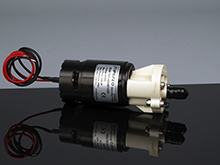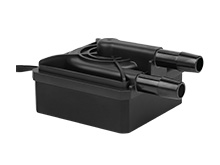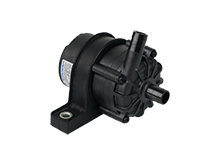Pump Working Principle
2018-06-18
Pump is mainly to transfer water, oil, acid & alkali chemical liquid, and liquid metal, also can transfer gas liquid mixture and fluid containing particles. In this article, we’re going to learn the working principle and characteristics of different pumps. Hope it helps you a better understanding of pumps.
When a
centrifugal pump works, liquid fills in the pump head and the impeller rotates at high-speed. Under the action of centrifugal force, the liquid run through the pump impeller at that high speed, thus the dynamic pressure becomes static water head.
Features:
a.Energy-efficient
CFD (computational fluid dynamics) was used to calculate the relationship between pressure distribution and velocity distribution inside the pump, by which we can optimize the pump flow channel design and improve the pump hydraulic efficiency.
b.Easy installation & maintenance
With vertical pipeline structure, pump inlet & outlet can be mounted in any position and by any direction as a valve.
c.Stable and safe operation
The pump and motor shares with the same shaft. With high concentricity, pump belongs to mechanical-electrical integration products, with features of compact structure and stable performance.
d.Shaft sleeve
The mechanical sealing of shaft is relatively easy to be corroded. Once the shaft is corroded, there will be mechanical sealing failure. TOPSFLO mainly adopt food grade graphite for shaft sleeve, which can avoid corrosion, increase the pump life span, and reduce the maintenance cost.
TOPSFLO
micro diaphragm pump and compressor are based on a simple principle, the circular power from the motor is converted into oscillating movement by an eccentric, which moves up and down its central point, this motion is then transferred to a diaphragm by means of a connecting rod, an elastic diaphragm, which in conjunction with an inlet and outlet valve creates a pumping action.
Features:
Pneumatic diaphragm pump adopts a new type of conveying machinery, which belongs to the one of the most innovative pumps. Using compressed air as a driving source, the air cylinder is completely separated from medium, so diaphragm pump can be well compatible with various corrosive liquid and air. The wetted materials usually adopt PTFE, EPDM, FPM, FFPM, etc according to different medium, in order to meet the needs of different users.
a.No overheat
Powered by compressed air, when diaphragm pump exhausts, it is an endothermic process. The inside temperature will be decreased when it works, and non-harmful gas emission.
b.No electric spark
The pump is driven by pneumatic, not by electricity directly, without the risk of electrostatic spark.
c.Extreme chemical resistance
The use of chemically resistant materials optional, such as PTFE, EPDM, FPM, FFPM, allows the corrosive gas and liquid to be pumped.
d.Uncontaminated flow
No contamination of the media due to oil-free operation.
e.Highest performance and size ratio
Innovative and efficient engineering designs enable the TOPSFLO diaphragm pump to push the performance envelope in a lightweight, compact size.
f.High efficient
Diaphragm pump will always keep high efficient, and abrasion will not lead to efficient reducing.
g.High level of tightness
Thanks to stress-optimized structured diaphragm, newly-designed valves, sealing system, and precise placement of the pump head, diaphragm pump can ensure high level of gas and liquid tightness
When two gears separate, the liquid will be inhaled and flow to the other side along the shell wall; on the other side, two gears close, there will be high pressure and the liquid will be discharged.
Features:
a.Lightweight and compact size
b.High manufacturability
c.Strong self-priming function
d.Extreme chemical resistance
e.Wide range of rpm
f.Resistance to high loaded impact










.jpg)

